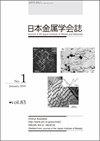Cu和Ni加入对Sn-Cu-Ni钎料合金高温变形行为的影响
IF 0.4
4区 材料科学
Q4 METALLURGY & METALLURGICAL ENGINEERING
引用次数: 0
摘要
近年来,由于使用含铅材料引起的环境问题日益严重,有必要开发铅替代品,例如无铅焊料合金。此外,在下一代半导体器件中,使用无铅焊料合金的电子元件需要更小,并能在更高的工作温度下使用。因此,必须使无铅焊料合金更加可靠。本文对锡-铜-镍(Sn - cu - ni)钎料合金、Sn - cu钎料合金和Sn - ni钎料合金以及99.96质量%纯锡进行了拉伸试验。结果表明,在Sn中加入Cu和Ni对Sn - Cu - Ni钎料合金的高温变形行为有影响。各合金和Sn的应力指数均大于5。结果表明,各试样的高温变形均受位错蠕变控制。蠕变活化能与应力有关,其中Cu对蠕变活化能的影响最大。(doi: 10.2320 / jinstmet.J2016069)本文章由计算机程序翻译,如有差异,请以英文原文为准。
Effect of Cu and Ni addition on high temperature deformation behavior in Sn-Cu-Ni solder alloys
In recent years, it has become necessary to develop lead substitutes, such as lead–free solder alloys, because of increased environmental concerns regarding the use of leaded materials. In addition, electronic components that use lead–free solder alloys will need to be smaller and usable at higher operating temperatures in next–generation semiconductor devices. Therefore, lead–free solder alloys must be made more reliable. In this work, tin–copper–nickel (Sn–Cu–Ni) solder alloys, Sn–Cu solder alloys, and Sn–Ni solder alloys, as well as 99.96 mass% pure Sn, were subjected to tensile testing. The results showed the effects of adding Cu and Ni to Sn on the high–temperature deformation behavior of the Sn–Cu–Ni solder alloys. For each alloy and Sn, the stress exponent was estimated to be >5. This result indicated that, in each sample, the high–temperature deformation was controlled by dislocation creep. Furthermore, the creep activation energy was dependent on stress, and was affected to the greatest extent when adding Cu. [doi:10.2320/jinstmet.J2016069]
求助全文
通过发布文献求助,成功后即可免费获取论文全文。
去求助
来源期刊

Journal of The Japan Institute of Metals
工程技术-冶金工程
CiteScore
0.70
自引率
0.00%
发文量
27
审稿时长
6-12 weeks
期刊介绍:
Information not localized
 求助内容:
求助内容: 应助结果提醒方式:
应助结果提醒方式:


